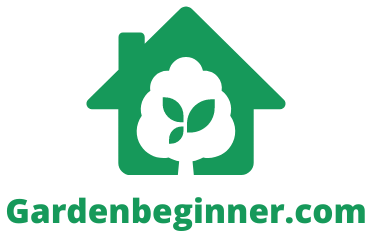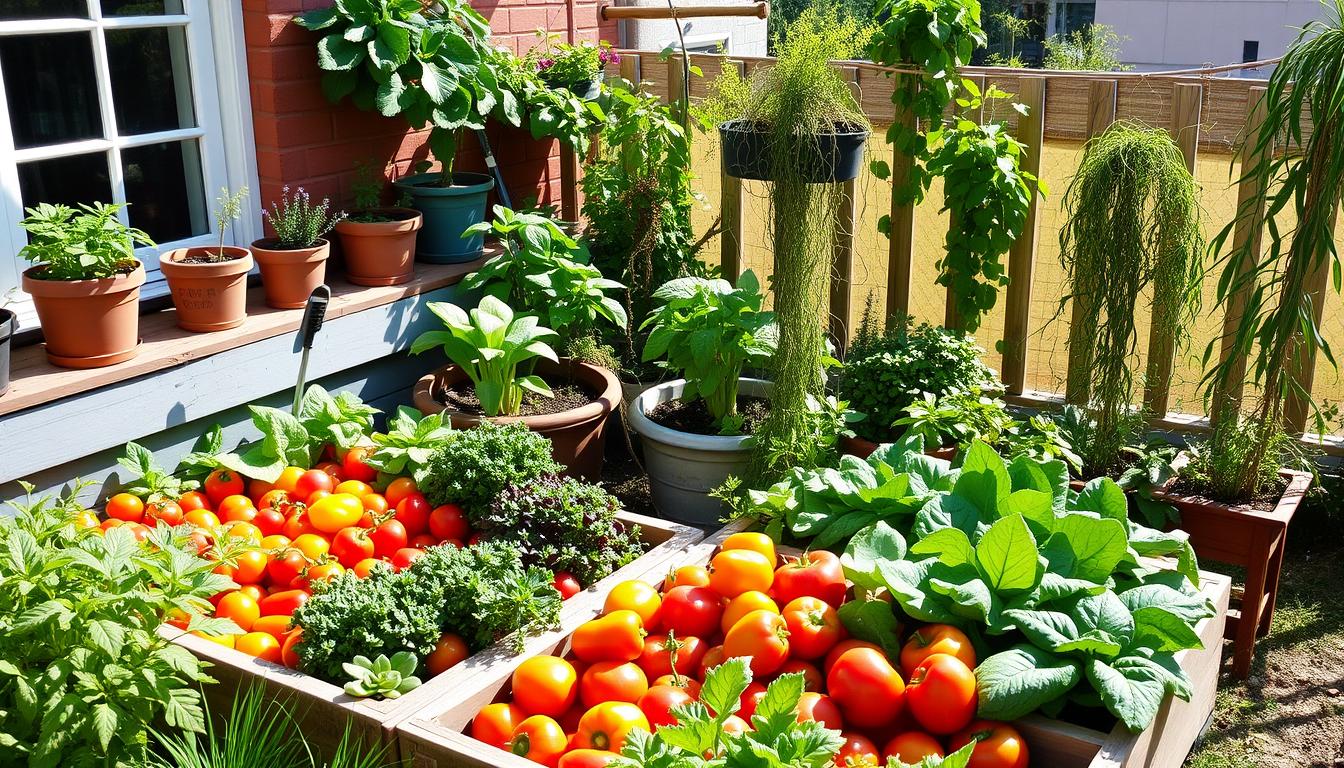In this guide, I’ll share expert tips for starting a small space vegetable garden. You can grow fresh produce even in tiny spaces. Follow these strategies for urban gardening and container gardening to enjoy your harvest.
Key Takeaways
- Maximize your available space by choosing the right containers and layout
- Select compact vegetable varieties that thrive in limited spaces
- Incorporate vertical elements like trellises and cages to grow more in less area
- Employ companion planting techniques to boost productivity and pest control
- Implement water-efficient irrigation methods to ensure your garden stays healthy
Assess Your Available Space
Starting a small space vegetable garden begins with evaluating your space. This step is key because it sets the size and number of containers or raised beds you can have.
Evaluate Sunlight Exposure
Most veggies need at least 6 hours of direct sunlight a day. Observe your area to see where the sun shines the most. This ensures your plants get enough sunlight.
Measure the Area
After finding the sunniest spots, measure the space. Use a tape measure to get the length and width. This info helps decide how big your containers or raised beds can be for your small space vegetable garden.
By assessing your garden space, evaluating sunlight needs for veggies, and measuring the area, you’re setting up for a successful garden. It will give you a rich harvest.
“The key to a thriving small space vegetable garden is understanding the unique conditions of your available space.”
Choose the Right Containers
For growing veggies in tight spots, traditional gardens might not work. Instead, smart gardeners use containers, planters, and raised beds. These options let you control the soil and make the most of small spaces.
It’s important to pick containers that are at least 12 inches deep. They should also have good drainage holes. Raised beds are great too. They let you create the perfect soil mix and use your space wisely.
| Container Type | Depth Requirement | Benefits |
|---|---|---|
| Containers/Planters | 12+ inches | Versatile, portable, customizable soil |
| Raised Beds | 8-12 inches | Improved soil quality, better drainage, easy access |
For best containers for small space gardening, focus on depth over width. This helps your container gardening vegetables grow well. Raised beds for small spaces are also a great choice for making the most of your area.
“Containers and raised beds are game-changers for small-space vegetable gardeners. They allow you to control the growing conditions and pack a lot of productivity into a small footprint.”
Prepare the Soil
Healthy soil is key for a successful small space vegetable garden. Start by filling your containers or raised beds with a top-notch, nutrient-rich organic potting mix. This mix is made for container gardening, giving your plants the nutrients and drainage they need to grow well.
Invest in Quality Potting Mix
When picking a soil preparation for container gardening, choose a mix without pests or diseases. Look for a mix with peat moss, compost, and perlite. These ingredients help with aeration and water retention.
Add Compost or Fertilizer
To make the soil even better, add a lot of compost for vegetable gardens. Compost adds organic matter that improves soil structure and gives nutrients to your plants. You can also use a slow-release organic fertilizer for extra nutrients.
| Soil Preparation Tip | Benefit |
|---|---|
| Use a high-quality organic potting mix | Provides essential nutrients and optimal drainage for container gardening |
| Amend the soil with compost or slow-release organic fertilizer | Improves soil structure and supplies a steady supply of nutrients for your plants |

“Healthy soil is the foundation of a thriving small space vegetable garden.”
Select Suitable Vegetables
When planning your small-space vegetable garden, picking the right varieties is key. Choose compact or dwarf cultivars that need less space. These plants help you make the most of your small garden and get a big harvest.
Consider Compact Varieties
Some great compact vegetable options for small gardens include:
- Cherry tomatoes – Indeterminate varieties like ‘Tumbling Tom’ or ‘Patio’ produce flavorful, bite-sized fruits without taking up too much room.
- Bush beans – Varieties like ‘Blue Lake’ and ‘Provider’ grow upright and can be grown in containers or small raised beds.
- Zucchini – Compact bush-type zucchini cultivars like ‘Raven’ and ‘Cashflow’ produce abundant yields without sprawling across your garden.
- Carrots – Try short, stubby carrot varieties like ‘Thumbelina’ or ‘Nantes’ that are perfect for small spaces.
- Lettuce – Loose-leaf and mini-head lettuces like ‘Buttercrunch’ and ‘Spretnak’ are ideal for growing in containers or small raised beds.
- Herbs – Grow space-saving herbs like basil, chives, parsley, and thyme in pots or window boxes.
By choosing these best vegetables for small spaces, you can have a thriving garden, even in tiny outdoor areas.
How to Start a Vegetable Garden in Small Spaces
Starting a small space vegetable garden is exciting and rewarding. It’s great for beginners or those expanding their urban garden. Let’s look at the key steps and the beginner’s guide to small space gardening.
First, check the space you have and plan the layout for your containers or raised beds. Make sure you know how much sunlight the area gets. This will help you choose the right vegetables to grow. Measure the area well to use your space wisely.
Then, pick the right containers or raised beds for your needs. You can choose from compact planters, vertical towers, or even old items. This will make your urban vegetable gardening setup look good and work well.
Preparing the soil is very important for your garden’s health. Get a good potting mix that drains well and has nutrients. Adding compost or fertilizer will help your plants grow strong.
Choose vegetables that grow well in small spaces, like cherry tomatoes and leafy greens. Plan where each plant goes to avoid overcrowding. This will help you get more from your garden.
By following these steps and using the beginner’s guide to small space gardening, you’ll have a great garden. Enjoy the fun of urban gardening and grow your own food at home.
Maximize Vertical Space
One of the best ways to use a small garden is to grow vertically. Use trellises, cages, or stakes for vining crops like tomatoes, cucumbers, and pole beans. This saves space and improves air flow, making it easier to harvest.
Embrace Trellises and Cages
Trellises and cages are key for vertical gardening in small spaces. They help plants grow up instead of spreading out. This saves space and makes your small-space vegetable garden look better.
When picking trellises and cages, look for sturdy, durable ones. Make sure they fit your plants’ needs. Choose based on your plants’ size and weight to keep everything stable.
| Vegetable | Recommended Trellis or Cage |
|---|---|
| Tomatoes | Cages or Tall Stakes |
| Cucumbers | Vertical Trellis |
| Pole Beans | Tiered Trellis or Teepee |
| Peas | Trellis or Netting |
Using vertical gardening techniques for small spaces boosts your garden’s productivity. You can get a lot from a small area, even in tight spots.
Incorporate Companion Planting
In a small space vegetable garden, companion planting can be a game-changer. This method involves growing different plants together. They help each other, increase yields, and keep pests away.
For companion planting in small space gardens, pick beneficial plant pairings that work well together. Some classic examples include:
- Planting marigolds around your vegetable plants to repel pests like aphids and nematodes.
- Growing basil near tomatoes to improve the flavor and deter pests.
- Combining carrots and radishes, as the radishes help loosen the soil for the carrots.
By incorporating companion planting in your small space garden, you can use natural pest control. This creates a thriving, bountiful oasis, even in limited space.
“Companion planting is a time-honored technique that can transform a small space into a productive and resilient garden.” – Jane Doe, Horticulturist
To start, research which plants pair well together. Then, try different combinations in your garden. With a bit of planning and creativity, you can make your small garden a harmonious and fruitful oasis.
Water Wisely
Proper watering is key for a successful small space vegetable garden. Keeping the soil moist is vital for your plants to grow well. Try not to overwater or let the soil get too dry.
Invest in Efficient Irrigation
To save water and keep your plants moist, think about using efficient irrigation. Drip lines or soaker hoses are great because they water the roots directly. This cuts down on water loss and evaporation. Check the soil moisture often and adjust your watering schedule to keep your small space gardens hydrated.
Using moisture-saving gardening techniques can also help with water use. Mulching and using self-watering containers can cut down on the water needed for your container gardens.
| Irrigation Method | Water Efficiency | Maintenance |
|---|---|---|
| Drip Irrigation | High | Low |
| Soaker Hose | High | Moderate |
| Sprinklers | Low | High |
“Implementing efficient water management for small space gardens is essential for the long-term success of your vegetable garden.”
Pest and Disease Management
Keeping a small space vegetable garden healthy can be tough. Pests and diseases can harm your plants quickly. But, with the right methods, you can manage these issues and keep your garden growing well.
Organic Pest Control Strategies
For pest control in small space gardens, choose organic methods. Watch your plants for pests like aphids, slugs, or caterpillars. If you see them, remove them by hand or use natural sprays like neem oil or insecticidal soap.
Introducing beneficial predators like ladybugs or lacewings can help. They eat pests that harm your crops. Also, some herbs and flowers can keep insects away.
Addressing Common Vegetable Garden Diseases
Common vegetable garden diseases can also be a problem. Watch for signs like yellow leaves, wilting, or discoloration. Act fast to stop diseases from spreading.
Good organic pest management and garden hygiene are key. Make sure your soil drains well and plants get enough air. This helps prevent fungal infections.
| Common Vegetable Garden Pests | Organic Control Methods |
|---|---|
| Aphids | Spray with neem oil or insecticidal soap, introduce ladybugs |
| Slugs and Snails | Use beer traps, sprinkle diatomaceous earth, place copper barriers |
| Caterpillars | Hand-pick and remove, use row covers, introduce beneficial wasps |
Use a mix of these organic pest management methods. Stay alert for disease signs. This way, your small space garden will stay healthy and productive, without harsh chemicals.

Conclusion
Follow the tips in this guide to make even the smallest spaces into great vegetable gardens. You’ll love growing your own food. Plus, you’ll get many benefits like fresh, healthy food, less environmental harm, and a fun hobby.
With some planning and effort, you can make your small space a garden full of fresh food. Remember to pick the right spot, choose the best containers, and prepare the soil well. Also, pick vegetables that grow well in small spaces.
Try using vertical gardening and planting vegetables together to get more from your space. As you start your garden, don’t forget to water right, watch out for pests, and enjoy growing your plants. The joy of eating your own veggies will be worth all the work.
So, start your small garden today. Enjoy the tasty fruits of your labor.



Leave a Reply